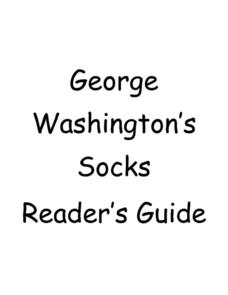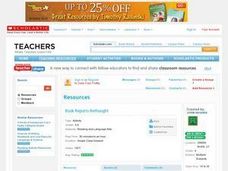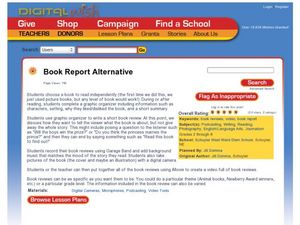Teach-nology
The Purpose of Summaries
How can you tell the author's purpose from just a short summary? Kids read three different summaries of books to determine whether the author meant to entertain, persuade, or inform.
PB Works
George Washington’s Socks Reader’s Guide
Dive into a class reading of the book George Washington's Socks with the help of this guide. Including a vocabulary list and series of comprehension questions for each chapter, this resource provides an excellent foundation for exploring...
EngageNY
Building Background Knowledge: The Boy Who Invented TV, “Life before Philo”
Walk through the pictures to understand the text. Scholars analyze The Boy Who Invented TV: The Story of
Philo Farnsworth by taking a book walk and looking at the pictures. They then do a first read of Life before Philo to determine the...
Curated OER
How to Summarize
Students review techniques on how to read a passage smoothly making the words connect, and with expression. They then read the instruction to the chapter in their science book and answer questions that are written on the board. They...
Curated OER
Book Reports Rethought
Students write unique book reports. In this book report assignment, students choose a creative way from a teacher-provided list to demonstrate that they read a book.
Curated OER
How Can We Write A Story Using Dr. Seuss' Writing and Illustration Style?
Students write a story. In this writing style and illustration lesson, students review elements of Dr. Seuss' writing and illustration style and read a few more books written by him, examining the writing style. Students work in...
Curated OER
Book Report Alternative
Students create a video book report. In this literature lesson, students read a book independently and fill out a graphic organizer. Students use a digital camera to record their book review.
Curated OER
All About Me Lesson
Students explore psychology by writing about themselves. For this personality lesson, students answer a list of questions that help analyze their own traits and history. Students create a personal "All About Me" book which they share...
Curated OER
Letter Writing -Traditional and Modern
Third graders study the parts of a friendly letter and how to address an envelope. They write pen pal letters using traditional and modern mailing practices.
Curated OER
Express Yourself Lesson Seed 17: Obituary
The Cay has been criticized by groups such as the Council on Interracial Books for Children because of the way race is portrayed. Explore the argument against the book while taking the author's perspective into account. Class members...
Curated OER
Whittle, Whittle it Down: Summarizing
Middle schoolers summarize a one to two page article of informational text. They compose a summary according to the guidelines on the "Five Rules for Writing a Summary" chart. They take turns reading their summary to the group, and...
Harper Collins
The World of Ramona
Bring the fun and whimsy of Beverly Cleary into your classroom with a teaching guide created to accompany the Ramona series. The guide offers several ideas for classroom use, including independent reading, reading aloud, and literature...
Curated OER
Literary Analysis: Summary vs. Analysis
What is the difference between summary writing and literary analysis? A 16-slide presentation offers some basic requirements for both types of writing and helps readers identify each based on keywords used in both types of writing....
Curated OER
My Antonia: K-W-H-L Strategy
Use the well-known KWHL chart as a tool for building up to a research project and oral presentation related to Willa Cather's My Antonia. Starting with a class brainstorm, pupils research and gradually narrow down topics relating to...
Curated OER
Documenting Sources: An Introduction to Incorporating and Documenting Outside Sources in Your Writing
Text heavy, the 16 slides in this presentation provide specific examples to introduce researchers to documenting outside sources in expository writing. A follow-up activity or worksheet would provide an opportunity for guided practice.
Curated OER
The Furry News: How to Make a Newspaper
Students investigate the process of making a newspaper using children's literature to create context for the lesson. The readers are asked to predict the events of the story as it is read to them. Then the teacher uses guided questions...
University of Kansas
Newspaper in the Classroom
Newspapers aren't only for reading—they're for learning skills, too! A journalism unit provides three lessons each for primary, intermediate, and secondary grades. Lessons include objectives, materials, vocabulary, and procedure, and...
Prestwick House
Reading Nonfiction: Analyzing Joseph McCarthy's "Enemies from Within" Speech
Looking for a instructional activity that teaches class members how to analyze nonfiction? Use Joseph McCarthy's famous "Enemies from Within" speech as a instructional text. Worksheet questions direct readers' attention to the many...
Curated OER
Accordion-Book Summary
Students explore summarizing. In this book report instructional activity, students follow directions to make an accordion book, including illustrating and summarizing important events in the story.
English Enhanced Scope and Sequence
Media Literacy with Focus of Strategies for Collaboration
Introduce your class to literary analysis with a series of activities that has them examine book and movie reviews. Groups then draft their own review of a text, select a digital medium, and craft a presentation.
Curated OER
Newbery Award Winners
Sixth graders select a book from the Newbery list and read it. They write a short summary of the book without giving away the ending and then research the book's author. They write a book review and, finally, incorporate all of this onto...
Scholastic
Frindle Lesson Plan
"Who says a pen has to be called a pen? Why not call it a frindle?" Inspired by this quote from the award-winning novel written by Andrew Celements, this lesson allows children to invent their own terms for common classroom objects,...
ARKive
Temperate Rainforest in the Pacific Northwest
Explore the amazing temperate rainforest of the Pacific Northwest. Your class starts by investigating the animals and plants of the Northwest, specifically Washington, and then research an animal population common to the area. In small...
Computer Science Unplugged
Kid Krypto–Public-Key Encryption
Class members have an opportunity to experience how to use a public key to encrypt information and a private key to decrypt it. Groups create their own public key and encrypt information then develop private keys to decrypt this...

























